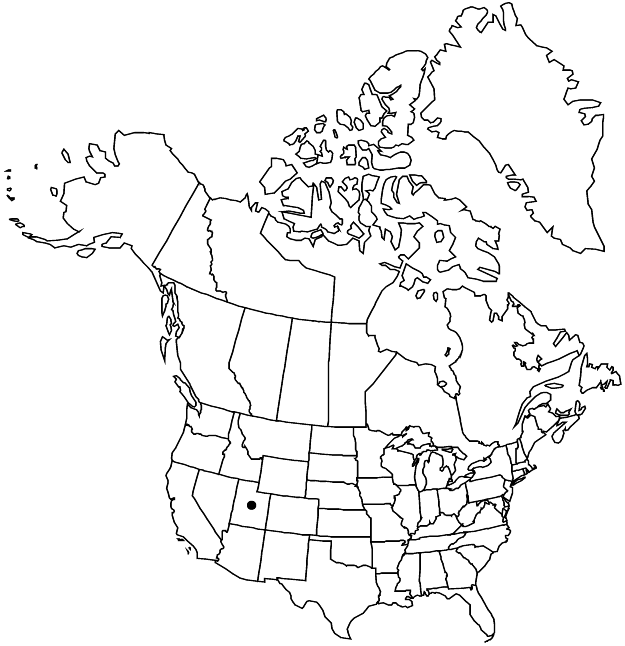Difference between revisions of "Eriogonum smithii"
Great Basin Naturalist 27: 202, fig. 6. 1968.
FNA>Volume Importer |
FNA>Volume Importer |
||
| Line 28: | Line 28: | ||
|distribution=Utah. | |distribution=Utah. | ||
|discussion=<p>Of conservation concern.</p><!-- | |discussion=<p>Of conservation concern.</p><!-- | ||
| − | --><p>Eriogonum smithii is restricted to the San Rafael Desert of Emery and Wayne counties. Plants from Little Gilson Butte (J. L. Anderson 86-228, BRY) have leaf blades thinly floccose on the abaxial surface but are otherwise similar to the shrubs found at Flat Top to the east. Smith’s wild buckwheat occurs in selenium-rich sands, which may limit its ability to be cultivated. The bright green, brilliantly yellow-flowered plants would make an elegant addition to the garden.</p> | + | --><p><i>Eriogonum smithii</i> is restricted to the San Rafael Desert of Emery and Wayne counties. Plants from Little Gilson Butte (J. L. Anderson 86-228, BRY) have leaf blades thinly floccose on the abaxial surface but are otherwise similar to the shrubs found at Flat Top to the east. Smith’s wild buckwheat occurs in selenium-rich sands, which may limit its ability to be cultivated. The bright green, brilliantly yellow-flowered plants would make an elegant addition to the garden.</p> |
|tables= | |tables= | ||
|references= | |references= | ||
| Line 52: | Line 52: | ||
|publication year=1968 | |publication year=1968 | ||
|special status= | |special status= | ||
| − | |source xml=https://jpend@bitbucket.org/aafc-mbb/fna-data-curation.git/src/ | + | |source xml=https://jpend@bitbucket.org/aafc-mbb/fna-data-curation.git/src/8f726806613d60c220dc4493de13607dd3150896/coarse_grained_fna_xml/V5/V5_489.xml |
|subfamily=Polygonaceae subfam. Eriogonoideae | |subfamily=Polygonaceae subfam. Eriogonoideae | ||
|genus=Eriogonum | |genus=Eriogonum | ||
Revision as of 18:39, 18 September 2019
Shrubs, erect to spreading, not scapose, (3–)4–10 × 5–20 dm, glabrous, bright green. Stems spreading, without persistent leaf bases, up to 1/3 height of plant; caudex stems absent; aerial flowering stems erect to spreading, slender, solid, not fistulose, 0.2–2 dm, glabrous. Leaves cauline on proximal 2/3 of stem, 1 per node; petiole 0.3–0.5 cm, floccose or glabrous; blade narrowly elliptic, 2.5–4.5 × (0.3–)0.6–1 cm, glabrous and green on both surfaces, rarely thinly floccose adaxially, margins occasionally slightly revolute. Inflorescences cymose, open to compact, 2–25 × 3–35 cm; branches often with involucres racemosely arranged at tips of inflorescence, glabrous; bracts 3, scalelike, linear to triangular, 1.5–4.5 mm. Peduncles absent. Involucres 1 per node, turbinate, (2.5–)3–3.5 × 2–2.5 mm, glabrous; teeth 5, erect, 0.3–0.5 mm. Flowers 3–4 mm; perianth yellow, glabrous; tepals connate proximal 1/4, slightly dimorphic, those of outer whorl obovate, 1.5–2 mm wide, those of inner whorl oblanceolate, 1–1.5 mm wide; stamens exserted, 2–5(–7) mm; filaments pilose proximally. Achenes brown, 3–3.5 mm, glabrous except for minutely papillate beak. 2n = 40.
Phenology: Flowering Jul–Oct.
Habitat: Deep, moving, red blow sand, mixed grassland and scrub oak communities
Elevation: 1400-1900 m
Discussion
Of conservation concern.
Eriogonum smithii is restricted to the San Rafael Desert of Emery and Wayne counties. Plants from Little Gilson Butte (J. L. Anderson 86-228, BRY) have leaf blades thinly floccose on the abaxial surface but are otherwise similar to the shrubs found at Flat Top to the east. Smith’s wild buckwheat occurs in selenium-rich sands, which may limit its ability to be cultivated. The bright green, brilliantly yellow-flowered plants would make an elegant addition to the garden.
Selected References
None.
